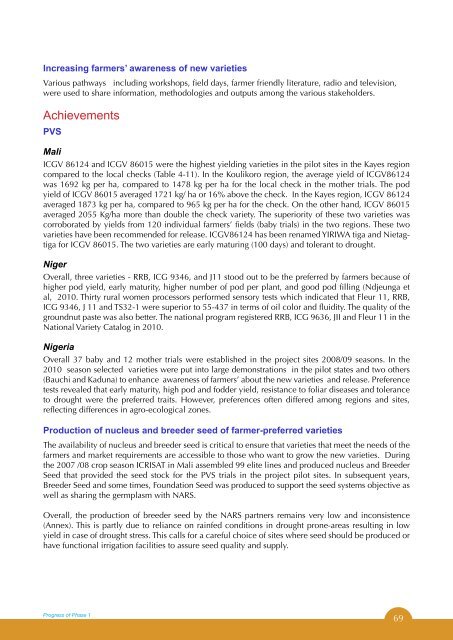Four Seasons of Learning and Engaging Smallholder Farmers - icrisat
Four Seasons of Learning and Engaging Smallholder Farmers - icrisat
Four Seasons of Learning and Engaging Smallholder Farmers - icrisat
You also want an ePaper? Increase the reach of your titles
YUMPU automatically turns print PDFs into web optimized ePapers that Google loves.
Increasing farmers’ awareness <strong>of</strong> new varieties<br />
Various pathways including workshops, field days, farmer friendly literature, radio <strong>and</strong> television,<br />
were used to share information, methodologies <strong>and</strong> outputs among the various stakeholders.<br />
Achievements<br />
PVS<br />
Mali<br />
ICGV 86124 <strong>and</strong> ICGV 86015 were the highest yielding varieties in the pilot sites in the Kayes region<br />
compared to the local checks (Table 4-11). In the Koulikoro region, the average yield <strong>of</strong> ICGV86124<br />
was 1692 kg per ha, compared to 1478 kg per ha for the local check in the mother trials. The pod<br />
yield <strong>of</strong> ICGV 86015 averaged 1721 kg/ ha or 16% above the check. In the Kayes region, ICGV 86124<br />
averaged 1873 kg per ha, compared to 965 kg per ha for the check. On the other h<strong>and</strong>, ICGV 86015<br />
averaged 2055 Kg/ha more than double the check variety. The superiority <strong>of</strong> these two varieties was<br />
corroborated by yields from 120 individual farmers’ fields (baby trials) in the two regions. These two<br />
varieties have been recommended for release. ICGV86124 has been renamed YIRIWA tiga <strong>and</strong> Nietagtiga<br />
for ICGV 86015. The two varieties are early maturing (100 days) <strong>and</strong> tolerant to drought.<br />
Niger<br />
Overall, three varieties - RRB, ICG 9346, <strong>and</strong> J11 stood out to be the preferred by farmers because <strong>of</strong><br />
higher pod yield, early maturity, higher number <strong>of</strong> pod per plant, <strong>and</strong> good pod filling (Ndjeunga et<br />
al, 2010. Thirty rural women processors performed sensory tests which indicated that Fleur 11, RRB,<br />
ICG 9346, J 11 <strong>and</strong> TS32-1 were superior to 55-437 in terms <strong>of</strong> oil color <strong>and</strong> fluidity. The quality <strong>of</strong> the<br />
groundnut paste was also better. The national program registered RRB, ICG 9636, JII <strong>and</strong> Fleur 11 in the<br />
National Variety Catalog in 2010.<br />
Nigeria<br />
Overall 37 baby <strong>and</strong> 12 mother trials were established in the project sites 2008/09 seasons. In the<br />
2010 season selected varieties were put into large demonstrations in the pilot states <strong>and</strong> two others<br />
(Bauchi <strong>and</strong> Kaduna) to enhance awareness <strong>of</strong> farmers’ about the new varieties <strong>and</strong> release. Preference<br />
tests revealed that early maturity, high pod <strong>and</strong> fodder yield, resistance to foliar diseases <strong>and</strong> tolerance<br />
to drought were the preferred traits. However, preferences <strong>of</strong>ten differed among regions <strong>and</strong> sites,<br />
reflecting differences in agro-ecological zones.<br />
Production <strong>of</strong> nucleus <strong>and</strong> breeder seed <strong>of</strong> farmer-preferred varieties<br />
The availability <strong>of</strong> nucleus <strong>and</strong> breeder seed is critical to ensure that varieties that meet the needs <strong>of</strong> the<br />
farmers <strong>and</strong> market requirements are accessible to those who want to grow the new varieties. During<br />
the 2007 /08 crop season ICRISAT in Mali assembled 99 elite lines <strong>and</strong> produced nucleus <strong>and</strong> Breeder<br />
Seed that provided the seed stock for the PVS trials in the project pilot sites. In subsequent years,<br />
Breeder Seed <strong>and</strong> some times, Foundation Seed was produced to support the seed systems objective as<br />
well as sharing the germplasm with NARS.<br />
Overall, the production <strong>of</strong> breeder seed by the NARS partners remains very low <strong>and</strong> inconsistence<br />
(Annex). This is partly due to reliance on rainfed conditions in drought prone-areas resulting in low<br />
yield in case <strong>of</strong> drought stress. This calls for a careful choice <strong>of</strong> sites where seed should be produced or<br />
have functional irrigation facilities to assure seed quality <strong>and</strong> supply.<br />
Progress <strong>of</strong> Phase 1<br />
69

















